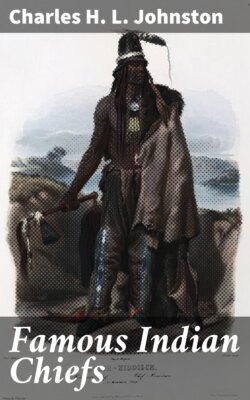Famous Indian Chiefs

Реклама. ООО «ЛитРес», ИНН: 7719571260.
Оглавление
Charles H. L. Johnston. Famous Indian Chiefs
Famous Indian Chiefs
Table of Contents
INTRODUCTORY
POWHATAN: THE GREAT SACHEM OF VIRGINIA
OPECHANCANOUGH: THE SCOURGE OF VIRGINIA
SASSACUS AND UNCAS: RIVAL CHIEFTAINS OF THE PEQUOT REBELLION
MASSASOIT: THE GREAT SACHEM OF THE WAMPANOAGS AND FRIEND OF THE PURITANS
KING PHILIP, OR METACOMET
PONTIAC: THE RED NAPOLEON
LOGAN: THE MIGHTY ORATOR AND WARRIOR OF THE MINGOES
RED JACKET, OR SA-GO-YE-WAT-HA: THE GREAT ORATOR OF THE SENECAS
CAPTAIN JOSEPH BRANT: THE WARRIOR CHIEF OF THE MOHAWKS
LITTLE TURTLE, OR MICHIKINIQUA: THE MIAMI CONQUEROR OF HARMAR AND ST. CLAIR
TECUMSEH, "THE SHOOTING STAR": CELEBRATED SHAWANOE DIPLOMAT, ORATOR AND SOLDIER
WEATHERFORD: THE CREEK CONSPIRATOR AND FEARLESS FIGHTER
BLACK HAWK: CHIEF OF THE SACS AND FOXES AND LEADER OF THE BLACK HAWK REBELLION
OSCEOLA: THE SNAKE OF THE FLORIDA EVERGLADES
ROMAN NOSE: THE CUSTER OF THE CHEYENNES
GERONIMO: THE TERRIBLE APACHE
RED CLOUD: THE SIOUX VON SEYDLITZ
SITTING BULL AND CRAZY HORSE: GENERAL AND ABLE LIEUTENANT OF THE GREAT SIOUX REBELLION
CONCLUSION
BOOKS FOR YOUNG PEOPLE
COSY CORNER SERIES
Отрывок из книги
Charles H. L. Johnston
Their Battles, Treaties, Sieges, and Struggles with the Whites for the Possession of America
.....
The Indian year was divided into five seasons—budding time, roasting ear time, summer time, the fall of the leaf, and the season of cold or winter. The savages amused themselves with sham fights, or with dances, and most hideous sounding noises, or war whoops, as they charged forward and retreated backward, around in a circle. Their musical instruments consisted of a reed cut to form a pipe, a drum made of wood with deer's skin stretched on the end, and rattles made of gourds or pumpkins. These made a terrible noise, which frightened more than delighted the first white settlers. When they had a distinguished visitor, they first spread a mat upon the ground for him to sit upon and then sat opposite him upon another. Then all present would join in a tremendous shouting to bid him welcome, after which two or more of the chief men would make an oration in which they testified their love and admiration for the visitor. After this a meal would be served and a pipe of peace would be passed around.
English adventurers had attempted to form a colony at Roanoke Island, just off the Virginia Coast, but it had been such a failure that the ardor of English voyageurs had been dampened and little effort had been made to gain a foothold in Virginia. But the Spaniards—their great rivals and enemies—had made numerous successful explorations in the New World, so that the pride of the Anglo-Saxons was piqued and their cupidity was aroused by the wealth the Spanish gold-seekers brought back to their own land. Thus, at the beginning of the reign of James I, it was determined to send ships and settlers to America, where they were to found a colony, search for gold, and ship it, when discovered, home to the mother country. There were several promoters for this scheme; one was a London merchant named Wingfield, another a clergyman named Hunt, still another, Bartholomew Gosnold, who had made a successful voyage to the coast of New England several years earlier. The most important was Captain John Smith, a gallant soldier-of-fortune, who had been in numerous adventures of a startling nature; had made many journeys in Europe; had been held captive by the Saracens, and who was a lover of all that was hazardous and full of danger. He was now twenty-eight years of age, strong, vigorous, handsome and energetic.
.....